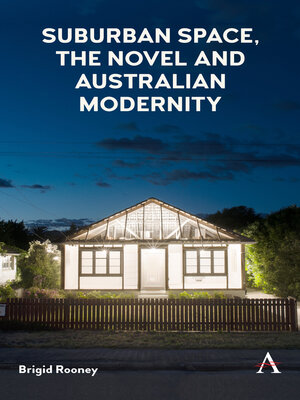Suburban Space, the Novel and Australian Modernity
ebook ∣ Anthem Studies In Australian Literature and Culture
By Brigid Rooney

Sign up to save your library
With an OverDrive account, you can save your favorite libraries for at-a-glance information about availability. Find out more about OverDrive accounts.
Find this title in Libby, the library reading app by OverDrive.



Search for a digital library with this title
Title found at these libraries:
| Library Name | Distance |
|---|---|
| Loading... |
'Suburban Space, the Novel and Australian Modernity' investigates the interaction between suburbs and suburbia in a century-long series of Australian novels. It puts the often trenchantly anti-suburban rhetoric of fiction in dialogue with its evocative and imaginative rendering of suburban place and time. 'Suburban Space, the Novel and Australian Modernity' rethinks existing cultural debates about suburbia – in Australia and elsewhere – by putting novelistic representations of 'suburbs' (suburban interiors, homes, streets, forms and lives over time) in dialogue with the often negative idea of 'suburbia' in fiction as an amnesic and conformist cultural wasteland. 'Suburban space, the novel and Australian modernity' shows, in other words, how Australian novels dramatize the collision between the sensory terrain of the remembered suburb and the cultural critique of suburbia. It is through such contradictions that novels create resonant mental maps of place and time. Australian novels are a prism through which suburbs – as sites of everyday colonization, defined by successive waves of urban development – are able to be glimpsed sidelong.
|'Suburban Space, the Novel and Australian Modernity' focuses on the dynamic interaction between suburbs and suburbia as this emerges in a century-long series of Australian novels – in works by Christina Stead, George Johnston, Elizabeth Harrower, Patrick White, Christos Tsiolkas and many other twentieth-century and contemporary writers. It puts the often trenchantly anti-suburban rhetoric found in these novels in dialogue with their evocative rendering of suburban place and time.
In the process, 'Suburban Space, the Novel and Australian Modernity' rethinks perennial literary and cultural debates about suburbia – in Australia and elsewhere. It does so by putting fictional 'suburbs' (their multitude of imagined interiors, homes, streets, forms and lives over time) into dialogue with cosmopolitan resistance towards the very idea of 'suburbia' as an amnesic and conformist cultural wasteland. 'Suburban space, the novel and Australian modernity' explores the generative collision produced in novels between the sensory remembered terrain of the primal suburb and wider cultural critiques of suburbia. It is through such contradictions that novels create resonant mental maps of suburban place and time. Australian novels, in other words, serve as a prism through which suburbs – real and imagined, remembered and utterly transformed – can be glimpsed sidelong.
'Suburban Space, the Novel and Australian Modernity' is a coinage that highlights both the persistence and the renovation of literary forms by means of the suburb. The suburbs prompt writers to experiment with the forms of the novel. The very scale of the suburb is productive, enabling narratives to slide readily from microcosm to macrocosm, from the domestic interior to the globe. Like suburbia, the novel is a form that is both generic and specific, circulating transnationally yet taking root locally. 'Suburban Space, the Novel and Australian Modernity' enacts a retrospective of Australian literary suburbia that reorients understanding of the political, cultural and literary significance of the suburbs. Novels about suburbs often play with time, looking into the past in order to summon what is lost. 'Suburban Space, the Novel and Australian Modernity' enacts a retrospective of Australian literary suburbia that reorients understanding of the political, cultural and literary significance of the suburbs.







